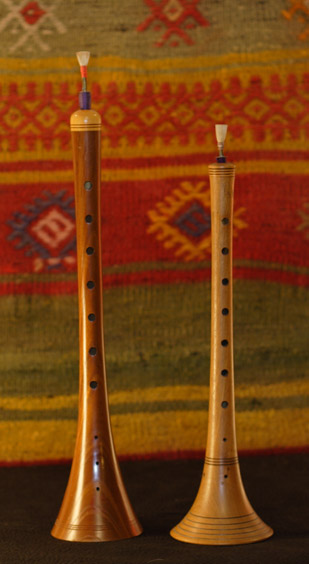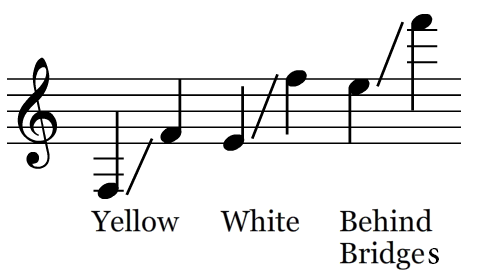|
Arabic Musical Instruments
Arabic musical instruments can be broadly classified into three categories: string instruments (chordophones), wind instruments (aerophones), and percussion instruments. They evolved from ancient civilizations in the region. Chordophones Plucked lutes *Oud *Qanbūs *Buzuq *Awtar *Lutar *Sintir Zithers *Qanun (instrument), Qanun *Iraqi Santur Bowed lutes *Jawzah *Ghuanbri *Kamancheh *Rababa *Pontic lyra Lyres *Simsimiyya *Kissar *Tanbūra (lyre), Tanbūra *Jewish Lyre Aerophones Flutes *Ney *Kawala, Kawalah *Salamiyyah (flute), Salamiyah *Minjayrah *Shababah *Shakuli *Furayrah *Kasab (flute), Kasab Reed instruments *Mizmar (instrument), Mizmar *Khalul (Gulfian Mizmar) *Ghayta *Arghul *Zumarah bi suwan *Maqrunah *Mijwiz *Haban (Gulfian Bagpipe) *Jirbah (East Tunisian Bagpipe) *Mizwad (West Tunisian Bagpipe) *Zughra (Moroccan Bagpipe) *Saksifun (Arabic Saxophone) Trumpets *Nafir (trumpet), Nafir Percussion instruments Drums and frame drums *Riq *Daf *Bendir *Goblet dr ... [...More Info...] [...Related Items...] OR: [Wikipedia] [Google] [Baidu] |
String Instruments
In musical instrument classification, string instruments, or chordophones, are musical instruments that produce sound from vibrating strings when a performer strums, plucks, strikes or sounds the strings in varying manners. Musicians play some string instruments, like Guitar, guitars, by plucking the String (music), strings with their fingers or a plectrum, plectrum (pick), and others by hitting the strings with a light wooden hammer or by rubbing the strings with a bow (music), bow, like Violin, violins. In some keyboard (music), keyboard instruments, such as the harpsichord, the musician presses a key that plucks the string. Other musical instruments generate sound by striking the string. With bowed instruments, the player pulls a rosined horsehair bow across the strings, causing them to vibrate. With a hurdy-gurdy, the musician cranks a wheel whose rosined edge touches the strings. Bowed instruments include the string section instruments of the orchestra in Western classic ... [...More Info...] [...Related Items...] OR: [Wikipedia] [Google] [Baidu] |
Iraqi Santur
The santur ( ; ) is a hammered dulcimer of Iranian origin.--- Rashid, Subhi Anwar (1989). ''Al-ʼĀlāt al-musīqīyya al-muṣāhiba lil-Maqām al-ʻIrāqī''. Baghdad: Matbaʻat al-ʻUmmāl al-Markazīyya. History The santur was invented and developed in the area of Iran. "The earliest sign of it comes from Assyrian and Babylonian stone carvings (669 B.C.); it shows the instrument being played while hanging from the player's neck" (35). This instrument was traded and traveled to different parts of the Middle East. Musicians modified the original design over the centuries, yielding a wide array of musical scales and tunings. The original santur was likely made with wood and stone and strung with goat intestines. According to Habib Hasan Touma, the Babylonian santur was the ancestor of the harp, the yangqin, the harpsichord, the qanun, the cimbalom, and the hammered dulcimers. Name The name 'santur' may come from Persian ''sanṭīr'', a borrowing of the Greek ψαλτήρ� ... [...More Info...] [...Related Items...] OR: [Wikipedia] [Google] [Baidu] |
Salamiyyah (flute)
A Salamiyyah is an open-ended small reed flute seen in Egypt. It is listed as a folk instrument as it is made from wood and is a part of folk music, specifically Sufi songs and dances Dance is an The arts, art form, consisting of sequences of body movements with aesthetic and often Symbol, symbolic value, either improvised or purposefully selected. Dance can be categorized and described by its choreography, by its repertoir .... It is an Arabic musical instrument in the aerophones category. References Arabic musical instruments Egyptian musical instruments {{woodwind-instrument-stub ... [...More Info...] [...Related Items...] OR: [Wikipedia] [Google] [Baidu] |
Kawala
The ''kāwālā'' ( or ; also called ''salamiya'', ) is an end-blown cane flute used in Arabic music. It is similar to the '' ney'' but has six finger holes, while the ''ney'' has seven (including one in the back). The ''kawala'' comes in up to nine different sizes, according to the '' maqam''. Though very similar to the ney, a highly popular flute in traditional Middle Eastern music, the kawala does not have a hole in the back as the ney does. The kawala has the fundamental tonal structure customary among the Egyptian folk music community, and the basis for many folk melodies, instrumental or vocal. The kawala is hollow and has four knots, with six fingerholes in a straight line along it. The instrument has up to nine different sizes, according to the scale required in a musical composition. Most often played today at religious festivals and weddings, it has its origin as a shepherds tool, used to guide their flock. For this reason the seems to assist in any musical composit ... [...More Info...] [...Related Items...] OR: [Wikipedia] [Google] [Baidu] |
Jewish Lyre
Jews (, , ), or the Jewish people, are an ethnoreligious group and nation, originating from the Israelites of ancient Israel and Judah. They also traditionally adhere to Judaism. Jewish ethnicity, religion, and community are highly interrelated, as Judaism is their ethnic religion, though it is not practiced by all ethnic Jews. Despite this, religious Jews regard converts to Judaism as members of the Jewish nation, pursuant to the long-standing conversion process. The Israelites emerged from the pre-existing Canaanite peoples to establish Israel and Judah in the Southern Levant during the Iron Age. John Day (2005), ''In Search of Pre-Exilic Israel'', Bloomsbury Publishing, pp. 47.5 8'In this sense, the emergence of ancient Israel is viewed not as the cause of the demise of Canaanite culture but as its upshot'. Originally, Jews referred to the inhabitants of the kingdom of JudahCf. Marcus Jastrow's ''Dictionary of the Targumim, Talmud Babli, Talmud Yerushalmi and Mid ... [...More Info...] [...Related Items...] OR: [Wikipedia] [Google] [Baidu] |
Tanbūra (lyre)
The tanbūra or "Kissar" is a bowl lyre of East Africa and the Middle East. Tanbūra traces its etymology to the Persian ''tanbur'' via the Arabic ''tunbur'' (), though this term refers to long-necked lutes. The instrument probably originated in Upper Egypt and the Sudan in Nubia and is used in the '' Fann At-Tanbura'' in the Persian Gulf Arab States. It also plays an important role in ''zār'' rituals. The tanbūra is a member of a family of lyres which can be found, with variations, in many areas throughout East Africa: compare the Ugandan Endongo and Kenya Nyatiti. According to ethnomusicologist Christian Poché, the Sudanese style of lyre has been played throughout "Egypt, Sudan, Djibouti, North Yemen, Southern Iraq and the Gulf States." In Sudan, the ''tanbūra'' (or ''tanbur'') is also called a ''rabāba''. The North Sudanese version is typically five-stringed with a larger size, while the ones from the South and the Nuba hills usually have six strings and are smaller ... [...More Info...] [...Related Items...] OR: [Wikipedia] [Google] [Baidu] |
Kissar
The ''kissar'' (also spelled ''kissir''), tanbour or gytarah barbaryeh is the traditional Nubian lyre, still in use in Egypt, Sudan and Ethiopia. It consists of a body having instead of the traditional tortoise-shell back, a shallow, round bowl of wood, covered with a soundboard of sheepskin, in which are two small round sound-holes. The arms, set through the soundboard at points distant about the third of the diameter from the circumference, have the familiar fan shape. Five gut strings, knotted round the bar and raised from the soundboard by means of a bridge tailpiece similar to that in use on the modern guitar, are plucked by means of a plectrum by the right hand for the melody, while the left hand sometimes twangs some of the strings as a soft drone accompaniment. File:Frederick Goodall, The Kissar Player.jpg, Egypt, 1859. ''The Kissar Player'',painting by Frederick Goodall File:النوبي الموسيقي.jpg, Man playing kissar in Egypt The kissar has been a popul ... [...More Info...] [...Related Items...] OR: [Wikipedia] [Google] [Baidu] |
Simsimiyya
The ''simsimiyya'' (Arabic: سمسمية, and سنسمية ''simsimyya/sinsimiyya''; pl. ''simsimiyyāt/sinsimiyyāt'') is a box or bowl lyre used in Egypt. Models exist with both circular soundboxes as well as rectangular. In the past, Egyptian models had 5 strings. The strings are held in place by pegs instead of tuning rings. Today, images of the instrument in Egypt may show 12 strings. It has been played since ancient times. It is used in Egypt in certain genres of Egyptian music, including ''Sawahli'' (coastal) music, which is a type of popular Egyptian music from the country's northern coast. The simsimiyya was probably introduced to the country's northern coast from the Nile valley in the 19th century by Egyptian workers in the Suez canal. It is also used in other genres of Egyptian music. Well-known Egyptian bands that feature the simsimiyya as a main instrument include El Tanbura, which uses other Egyptian instruments. The simsimiyya is often used to accompany Egypti ... [...More Info...] [...Related Items...] OR: [Wikipedia] [Google] [Baidu] |
Pontic Lyra
Pontic, from the Greek ''pontos'' (, ), or "sea", may refer to: The Black Sea Places * The Pontic colonies, on its northern shores * Pontus (region), a region on its southern shores * The Pontic–Caspian steppe, steppelands stretching from north of the Black Sea as far east as the Caspian Sea * The Pontic Mountains, a range of mountains in northern Turkey, close to the southern coast of the Black Sea Languages and peoples * Pontic Greeks, all Greek peoples from the shores of the Black Sea and Pontus * Pontic Greek, a form of the Greek language originally spoken by the Pontic Greeks (see above) * ''Pontic'', as opposed to ''Caspian'' (which refers to the possibly related Nakho-Dagestanian or Northeast Caucasian languages), is sometimes used as a synonym for the Northwest Caucasian language family. * Pontic languages, the hypothetical language family linking the Northwest Caucasian and Indo-European languages, and Proto-Pontic, the Pontic proto-language, is the reconstructed com ... [...More Info...] [...Related Items...] OR: [Wikipedia] [Google] [Baidu] |
Rababa
''Rebab'' (, ''rabāba'', variously spelled ''rebap'', ''rubob'', ''rebeb'', ''rababa'', ''rabeba'', ''robab'', ''rubab'', ''rebob'', etc) is the name of several related string instruments that independently spread via Islamic trading routes over much of North Africa, Middle East, Central Asia, Southeast Asia, and parts of Europe. The instrument is typically bowed, but is sometimes plucked. It is one of the earliest known bowed instruments, named no later than the 8th century, and is the parent of many bowed and stringed instruments. Variants There are chiefly three main types: A long-necked bowed variety that often has a spike at the bottom to rest on the ground (see first image to the right); thus this is called a spike fiddle in certain areas. Some of the instruments developing from this variant have vestigial spikes. A short-necked double-chested or "boat-shaped" variant; plucked versions like the ''Maghreb rebab'' and the ''kabuli rebab'' (sometimes referred to as t ... [...More Info...] [...Related Items...] OR: [Wikipedia] [Google] [Baidu] |



